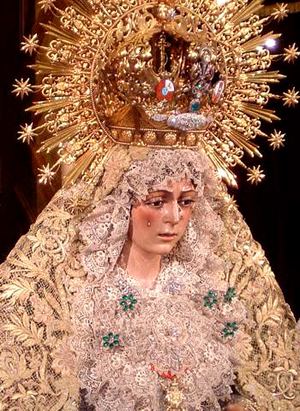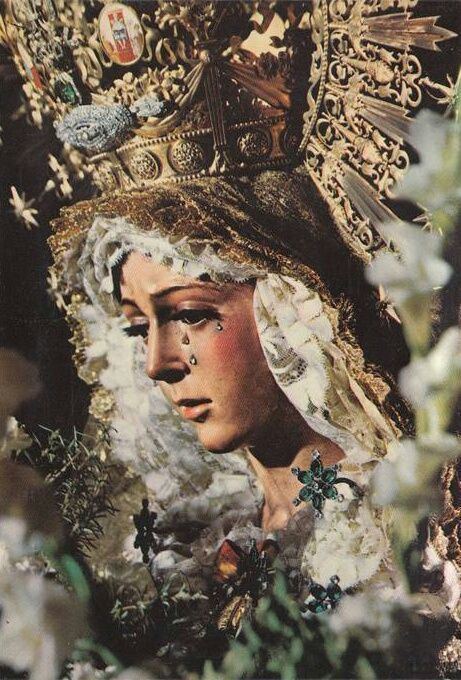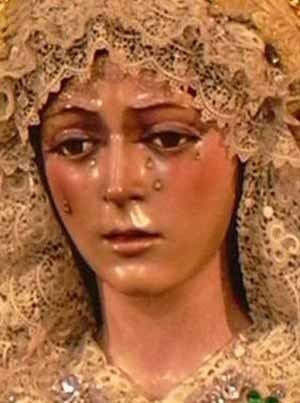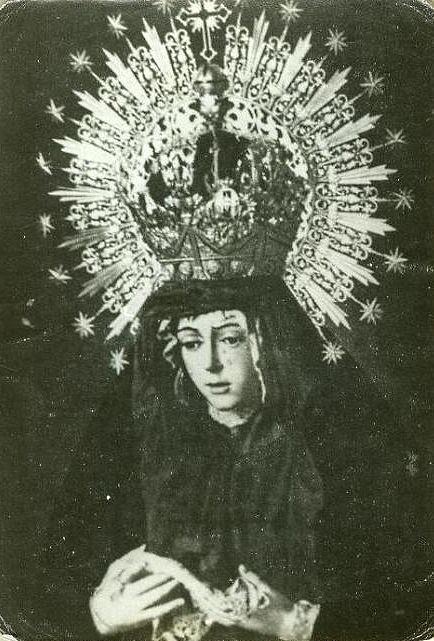Type Marian art Date 18 December | ||
 | ||
Shrine Basilica of Macarena, Cathedral of Seville Patronage People of Seville, bullfighters, tailors, embroiderers and liver donors Similar Jesús de la Sentencia, Nuestra Señora de la Espera, Jesús del Gran Poder, Virgin of El Rocío, María de la Soledad | ||
The Virgin of Hope of Macarena (Spanish: Virgen de la Esperanza de Macarena de Sevilla), popularly known as the Virgin of Macarena or simply La Macarena, is a pious 17th century Roman Catholic wooden image of the Blessed Virgin Mary venerated in Seville, Spain. The Marian title falls under a category of Our Lady of Sorrows commemorating the desolate grievance and piety of the Virgin Mary during Holy Week. The image is widely considered as a national treasure by the Spanish people, primarily because of its religious grandeur during Lenten celebrations.
Contents
- Basilica de la macarena seville mpg
- History
- Arson attempt
- Details of the image
- Canonical coronation
- References

The image is also known for local folklore, most notably its discolored cheek allegedly caused by a wine bottle thrown by a Protestant drunken rebel at her face which pious legends also claim it never been able to remove. Its popularity among the masses is often highlighted in the five Rose-Emerald brooches attached to her dress given by the famed bullfighter José Gómez Ortega and the historical fact that the image has only worn an entire black vestment ensemble on a singular point in Spanish history; during el Gallo's death and funeral.

The feast of the image is celebrated in Spain on 18 December and was granted a canonical coronation on 31 May 1964 by Pope John XXIII via Cardinal José Bueno y Monreal. The Virgin of Macarena is commonly considered the patroness of bullfighters, who hold a sincere devotion to the image. It is currently enshrined in the high altar of the Basilica of Macarena.

Basilica de la macarena seville mpg
History

The image's genuine authorship is unknown and widely disputed; often by art schools who wish to claim ownership of both its artistic style called Encarnacion. A similar image of the Virgin Mary and crucified Jesus was certainly in existence by 1654 by santero artist Pedro Nieto. Religious images of this type was a result of baroque reforms between 1670 and 1680 by the Confraternity of Macarena.

The image is scholarly attributed to the artist Pedro Roldán or one of his protégés in his workshop. Three other famous sculptors and their schools place claim on the image. Over time, the image fell into disrepair, but was officially restored in March 1881 by Emilio Pizzaro de la Cruz, who created new arms and hands; it was restored again in 1883.

By the early 20th century, the famous embroiderer Juan Manuel Rodríguez Ojeda, a member of the Confraternity of the Macarena devoted his work to the image as a gesture of thanksgiving. Between 1899-1900, the image began to showcase a mantle made of gold thread, French wire bullion and gold-plated tin, popularly referred to as a "mesh cape".
By 1908, a canopy of red velvet was added to protect the image from weather conditions, and was restored in 1964. Various crowns and accessories were repeatedly redesigned in 1938, 1953 and 1963.
A new cape was made in 1930, which was unique because the color emerald green was also used along with gold tones. King Alfonso XIII of Spain promoted its devotion by issuing a regal document on the image after being inducted into the fraternity in 1904. In the same year on 11 April, Cardinal Eustaquio Ilundáin y Esteban once again blessed the image and its new cape.
Folklore recounts an alleged tale of a Protestant rebel who drank (drinking is permitted on some religious processions) and then threw a wine bottle at the image sometime before the 1950s. He became a pallbearer for the image the following year as penance for his sacrilegious act.
The image was granted a canonical coronation on 27 March 1913 by Cardinal Enrique Almaraz y Santos, who added the five emerald brooches donated by the bullfighter El Gallo. A similar coronation was also repeated in 1964 by the Archbishop of Seville.
Arson attempt
During the Spanish Civil War, anti-clerical arsonists entered on the early dawn of 18 July 1936 attempting to destroy the images inside the Macarena church and its oratory. Out of fear, the people stole the images of Lord of Judgment and Lady of the Rosary and hid them under the warehouse underneath the church steps. Historically, religious images that are threatened by war or famine are often secretly buried underground for safekeeping. The Macarena image was stripped of its vestments and taken anonymously to one of the members of the Confraternity for safekeeping. Due to the warring factions at the time, the confraternity was expelled and was forced to move into the Church of the Annunciation.
Details of the image
The image belongs to an anonymous sculptor dating back to 1680, and measures 175 centimeters. It is a mannequin style image made of pine wood and cypress combination. The image features a sorrowful face with glass teardrops; along with a human wig and looks downwards. It has an open mouth complete with tongue and teeth. The image holds a mourning handkerchief (right) and Rosary (left). It also possesses a gold medal given by the mayor of the city from 1971.
Canonical coronation
Religious images of widespread devotions are often venerated in Spain through papal-designated ceremonies called canonical coronation. On 20 December 1962, the Confraternity of Macarena petitioned Pope John XXIII to grant a coronation. On 17 February 1963, the Pontiff answered this request with through Cardinal Paolo Marella; who agreed to move the image on 27 May 1964 to the Cathedral of Seville for a Triduum feast and Holy Mass. A High Pontifical Mass was celebrated and attended by the current head of state Francisco Franco.
Because recreating this image is considered very costly and painstaking, images of this title is often seen rare and limited. Other sanctioned copies under this particular Marian title alone have also been reproduced in other pious Catholic countries, namely in Colombia (7), Brazil (2), Uruguay (1), Venezuela (4) and the Philippines (2).
